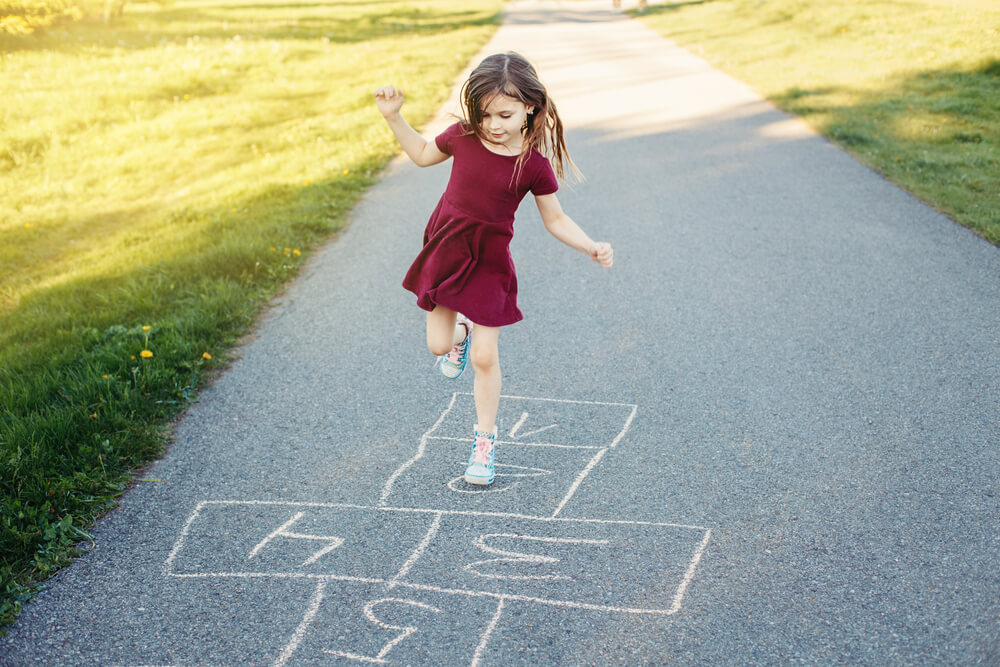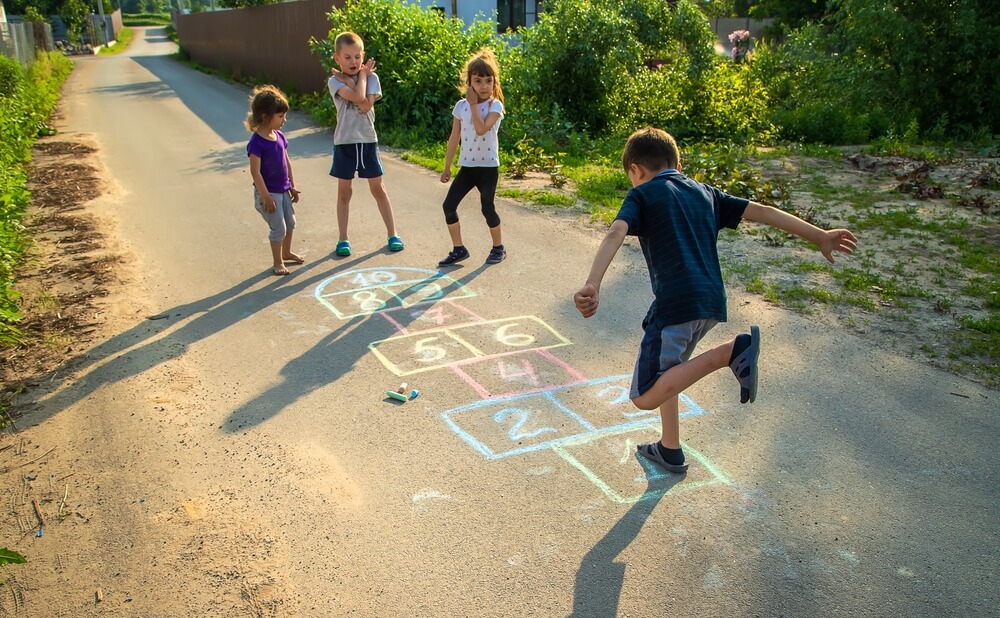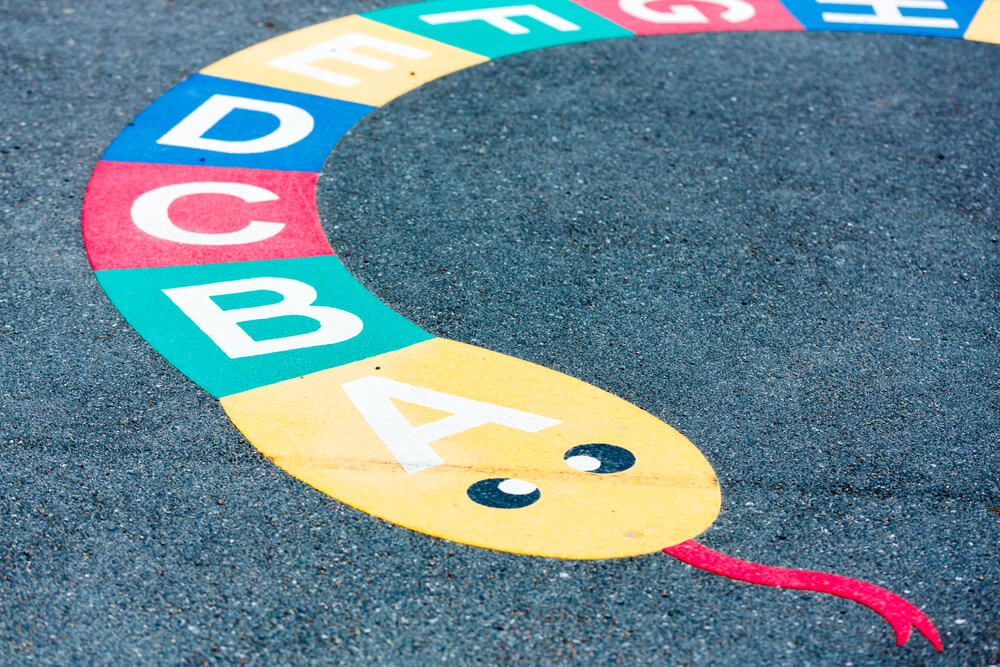Hopscotch Game Rules and Creative Ideas for Play

Remember those sunny afternoons spent outdoors, hopping on one foot from square to square, balancing with arms outstretched, and feeling the sheer exhilaration of landing that final jump?
Hopscotch isn’t just a game—it’s a portal to a simpler, joy-filled time.
Whether you’re a parent eager to introduce your child to this classic pastime, or an educator looking for fun, engaging ways to encourage physical activity, hopscotch is the perfect jumpstart (literally).
If you’re curious about how to play hopscotch, this guide is for you.
So, lace up your sneakers and grab some chalk—let’s dive into the timeless joy of hopscotch!
Contents:
- What Is Hopscotch?
- What is the Traditional Layout of Hopscotch?
- Things You Should Know Before You Start
- How Do You Play Hopscotch? Basic Rules
- Unique Hopscotch Game Variations
- FAQs
What Is Hopscotch?

Maria Sbytova/Shutterstock.com
Hopscotch is both simple and magical.
At its core, it’s a playground game that involves tossing a small object onto a numbered pattern of rectangles drawn or etched on the ground, then hopping or jumping through the spaces to retrieve the object. The objective is to complete the course without stepping on the lines or missing a square.
Hopscotch has a rich history that dates back to ancient times. The game is believed to have originated in Roman Britain, where soldiers created courses over 100 feet long to improve their footwork and endurance.
The name “hopscotch” itself comes from the Old English word “hoppe,” meaning to jump, and “scotch,” meaning to scratch or score. Over centuries, hopscotch evolved into various forms and spread across different cultures, each adding its unique twist to the game.
What is the Traditional Layout of Hopscotch?

misfire_studio/Shutterstock.com
The classic hopscotch layout is a series of numbered squares or rectangles arranged in a specific sequence. Here’s how you can draw it.
There are only two materials you’ll need: chalk (for outdoor play) or masking tape (for indoor play).
The first step is to find a flat, smooth surface where you can draw your hopscotch grid. Sidewalks, driveways, and gym floors are all excellent choices. The key is to ensure the surface is even, free of obstructions and safe for jumping.
Now, let’s dive into drawing the hopscotch layout:
- Square 1: Start by drawing a square directly in front of the starting point, which serves as the beginning of the game.
- Squares 2 and 3: Draw two squares side by side, directly above Square 1.
- Square 4: Place this square directly above Squares 2 and 3.
- Squares 5 and 6: Again, draw two squares side by side, directly above Square 4.
- Square 7: Place this square directly above Squares 5 and 6.
- Squares 8 and 9: Draw these two squares side by side, directly above Square 7.
- Square 10: This square goes at the top and is sometimes labeled as “Home” or “Safe.”
Additional Tips for Setting Up Your Hopscotch Grid

Anna Kraynova/Shutterstock.com
Here are a few insider tips on setting up your hopscotch grid (this way, you won’t find yourself having to redraw it halfway through or deal with the “she broke the rules!” meltdowns):
- Numbering: Use clear, bold numbers to mark each square from 1 to 10. This helps players easily identify the sequence.
- Square Size: Make sure each square is large enough for a child’s foot to comfortably fit inside. Typically, squares are about 1 foot by 1 foot, but you can adjust based on the available space and the players’ sizes.
- Spacing: Maintain consistent spacing between the squares. This ensures the game is fair and enjoyable for everyone.
- Decoration: Feel free to add some creative flair! Use colorful chalk or tape to make the grid more inviting. You can also decorate the surrounding area with additional designs or themes.
Still not sure how to play hopscotch? Here’s a quick YouTube video that will walk you through the steps. Or should we say, the jumps?
Hopscotch is not only a fun game but also a great way for children to develop balance, coordination, and motor skills. You can easily create a perfect hopscotch layout and ensure endless hours of entertainment. So, grab your chalk or masking tape and start drawing your hopscotch grid!
Things You Should Know Before You Start

Tatevosian Yana/Shutterstock.com
Before you embark on a fun-filled game of hopscotch, here are some essential tips and tricks to make sure you hop, skip, and jump your way to victory with style and finesse.
Understand and Review the Basics
As we’ve already discussed, hopscotch is a classic sidewalk game that involves hopping through a series of numbered squares while following a set pattern. The goal is to complete the course without stepping on the lines or losing your balance.
Before you start, familiarize yourself with the basic rules and layout of the hopscotch grid to set yourself up for success. Review the rules every time you play, especially if you’re playing with little ones—this way, you can make sure everyone is on the same page.
Choose the Right Surface
The surface you play on can greatly impact your hopscotch experience. Opt for a flat, smooth area free from debris or obstacles that could trip you up during the game.
Asphalt, concrete, or tiled surfaces are ideal for a traditional hopscotch setup, ensuring a stable and safe playing environment.
Practice Your Hopping Technique

Yuricazac/Shutterstock.com
Hopping may seem straightforward, but mastering the art of hopping gracefully from square to square can take some practice. Start by warming up with gentle hops to loosen up your muscles and improve your balance.
Experiment with different hopping styles—one foot, two feet, or even fancy twists—to find what works best for you.
Strategize Your Throws
In traditional hopscotch, players toss a small marker, like a rock, stone, or beanbag, into designated squares before beginning their hopscotch journey.
Practice your throwing skills to ensure accurate placement of the marker in the right square. A well-placed throw can make navigating the course easier and more enjoyable.
Focus and Concentration
Hopscotch requires focus, concentration, and quick reflexes as you hop through the squares in sequence.
Stay alert, keep an eye on the marker, and maintain a steady rhythm to avoid missteps and complete the course successfully. Engage your mind and body in sync to enhance your hopscotch performance.
Have Fun and Get Creative
While hopscotch has its rules and structure, don’t forget to inject a dose of creativity and fun into your gameplay.
Experiment with different hopscotch variations, create your own challenges within the game, and let your imagination run wild as you hop, skip, and jump your way through the course.
Make sure your kids stay safe while having fun with the Findmykids app. Track their location in real-time and ensure they are where they’re supposed to be, whether they’re playing hopscotch or exploring the neighborhood. Download the app today for peace of mind!
How Do You Play Hopscotch? Basic Rules

san4ezz/Shutterstock.com
Ready to hop into action? Here’s a step-by-step guide to playing traditional hopscotch:
- Throw the Marker: Players take turns throwing a small object (like a stone or beanbag) onto the numbered squares in order.
- Hop Through the Course: Starting from behind the first square, hop on one foot in single squares and both feet in side-by-side squares, skipping the square with the marker.
- Retrieve the Marker: On the way back, stop at the square before the marker and balance on one foot to pick it up.
- Continue: Players continue through all the squares in ascending order. If a player steps on a line, misses a square, or loses balance, they lose their turn.
- Winning the Game: The first player to complete the course from start to finish wins.
How to Play Old-School Hopscotch
Old-school hopscotch follows the same basic rules but often includes variations to keep things interesting. Here are a couple of classic twists:
- “Potsy”: In some regions, players must toss their marker into each square in numerical order. The challenge lies in maintaining balance while hopping into the correct squares and nailing your tosses.
- Multiple Players: In larger groups, divide into teams and add challenges like hopping on one leg or playing with a time limit.
Unique Hopscotch Game Variations

AlinaTuresson/Shutterstock.com
Looking to spice up the traditional game? Here are some unique variations to try:
- Alphabet Hopscotch: Instead of numbers, use letters for your hopscotch board to create a fun learning experience for younger kids. They can spell out words as they hop.
- Math Hopscotch: Turn hopscotch into an educational tool by adding math problems to each square. Players must solve the problem to advance.
- Fitness Hopscotch: Add exercises like jumping jacks or squats to certain squares on your hopscotch court to combine fun and fitness.
- Nature Hopscotch: Incorporate natural elements like leaves, sticks, or flowers into the game. Players must collect a specific item from each square.
Jumping to the Bottom Line

Africa Studio/Shutterstock.com
Encourage your kids to step away from screens and engage in outdoor play. Games like hopscotch help develop motor skills, balance, and coordination. Plus, it’s a fantastic way to spend quality time together.
Hopscotch is more than just a game—it’s a gateway to physical activity, learning, and fun.
Whether you’re a parent looking to bond with your child or an educator aiming to make playtime educational, hopscotch offers endless possibilities. Don’t hesitate to get creative with the game, adding unique twists to keep it engaging.
We’d love to hear about your hopscotch adventures! Share your experiences and unique variations in the comments below, or tag us in your photos on social media. Let’s keep the hopscotch spirit alive and hopping!
FAQs

Lopolo/Shutterstock.com
How do you play hopscotch?
To play hopscotch, players take turns throwing a marker onto a numbered square and then hop through the course on one foot, skipping the square with the marker. The goal is to retrieve the marker without stepping on any lines or losing balance.
What is the standard layout of the hopscotch?
The standard hopscotch layout consists of 10 numbered squares or rectangles arranged in a specific sequence: single squares (1, 4, 7, 10) and side-by-side squares (2-3, 5-6, 8-9).
What is the hopscotch pattern?
The traditional hopscotch pattern follows this order: Square 1, Squares 2 and 3 (side by side), Square 4, Squares 5 and 6 (side by side), Square 7, Squares 8 and 9 (side by side), and Square 10 at the top.
What is the original hopscotch?
The original hopscotch dates back to Roman Britain, where soldiers used it as a training exercise. The game has since evolved, with various cultures adding their unique twists, but the core mechanics of hopping through numbered squares remain the same.
The picture on the front page: Maria Sbytova/Shutterstock.com
Проверьте электронный ящик



















